Special Techniques
Barre
If you still think that there is a 3 strings and a 6 strings barre made with finger 1 then you are probably reading some obscure guitar treaty taken from the local book deposit. Change book ! Barre is a most too often wrongly used tool. For one thing barre drains the left hand of its energies in no time. The guitar harmonics are mostly dumped and we do not play an instrument that needs so much sound dumping. When the barre is used in a manner that makes it an asset in our playing than we are using it wisely. Sometimes the barre will stop 2 notes, other times the barre will be performed with finger 4 or 3. Other times finger 1 will go passed the 6th string literally in the air (Passing Barre). The core aspect to be kept in mind is that after a barre, which is maximum tension, relaxation must follow.
1) Standard, Flat Barre
This is the barre that will be used most times although it is wise to say that all barres contain one or more characteristics from the other types of barre.
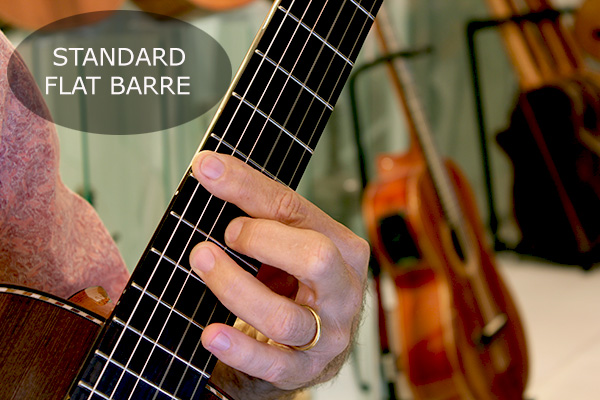
2) Barre to One Side
Using the side of finger 1 will take advantage of the less spongy consistency of the finger which may come in handy in some barring scenarios.
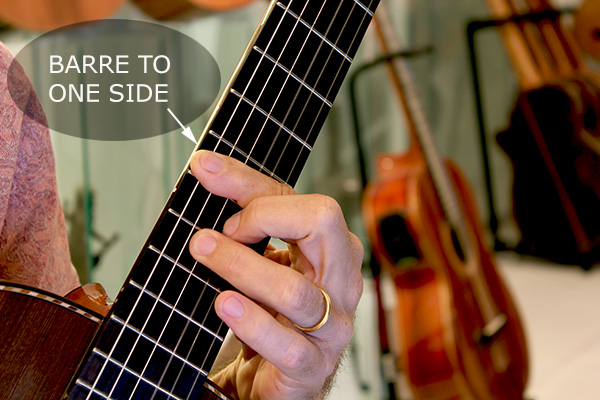
3) Passing Barre
The passing barre is the way to go when you need the more fleshy part of finger 1 (the part closer to the main knuckle) to stop the 3rd or 4th strings.
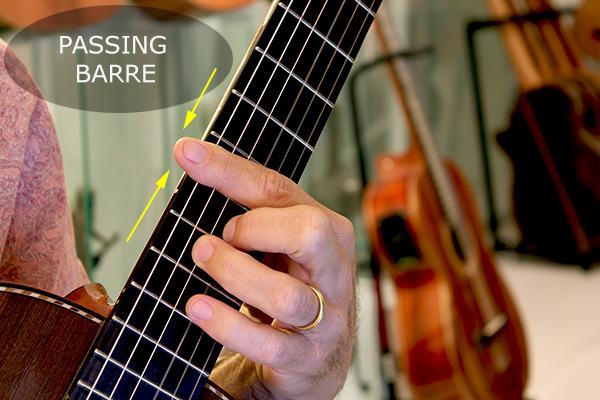
4) Bent Barre
I find the bent barre to be very helpful when trying to stop elusive notes on the second or third strings.
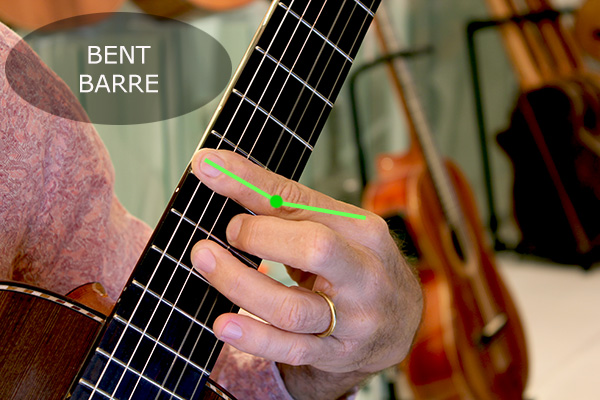
Below is an example of a "Bent Barre" taken from Recuerdos de la Alhambra Masterclass, staff # 7.

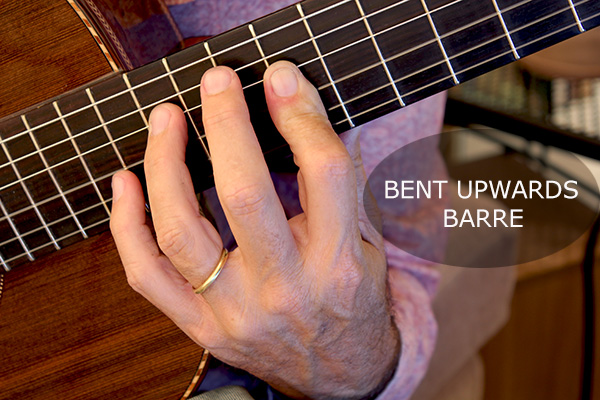
See the video of this Barre.
Below you can see how the left hand thumb goes to the lower part of the neck to help finger 3 make the stretch.
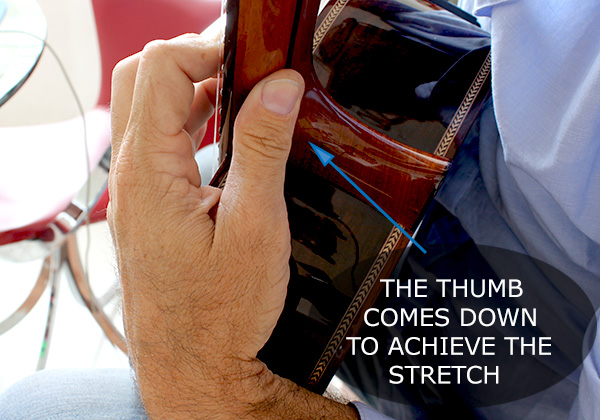
5) Special Barre
Although 99% of your Barre chords will be performed by finger 1, you will often come by situations where fingers 3 and 4 are called in to perform a 2 or 3 strings complementary type of barre.
Such is the case in Francisco Tárrega's "Recuerdos de la Alhambra", staff # 6.

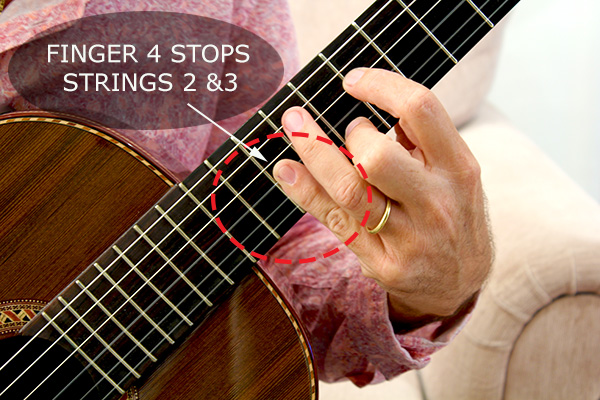
Following is a great exercise to develop barre: It is the opening section of the Aranjuez Concerto.
The way to practice these chords is the following:
1- Breath between chords.
2- Relax the left hand completely between chords.
3- When tension in the left hand mounts-up, stop, rest and start again.
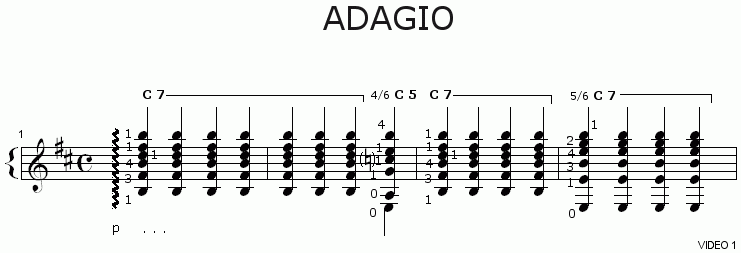

Barre is supposed to be a solution to technical problems. That is how it originally started. Somewhere along the way, players have forgot that and have started seeing barre as an obstacle... Apply these principles:
1- Make sure you know exactly which strings have to be pressed. Not all the strings in a full barre are necessarily played. Every string you press takes about 500 gm (half kilo) of strength from your hand on an average guitar. (Professional instruments only take 250 gm (one fourth of a kilo).
2- Once you figured out what strings get the pressure, start building the left hand position that uses the barre... For example in Romance, (part 1), put the full barre 7 down...(finger 1) ... you need to press strings 1, 2 and 6 only. ... you will be pressing some on the other strings as well but minimally... but put finger 2 down on the third string only a fraction of a second prior to actually playing the note. I stress fraction of a second because time is essential, you want to press the barre for the time necessary only, not a second longer than necessary.
3- When you are learning a piece, you stay on all positions (barres included) longer than necessary. Therefore, see it this way: it is less effort consuming to play up to tempo than in study mode.
4- When you are in study mode, stop the instant you feel pain or tension in the muscle in fig 3. Do not get used to playing with pain. The famous "no pain no gain" saying, is for weight lifters, not guitar players. We, guitar players, use "with pain no one gains".
5- Once you figured out all the barre position, play through it in parts, stopping at the first insinuation of pain.
Conclusion:
The Barre requires that you is use the playing apparatus very efficiently. Know exactly what is happening to your hands at all times.
Barre is a deficiency in guitar technique. I suppose nobody sat down to figure out an alternative solution to the capo. Always try to find an alternative fingering rather than simply giving in to barres. The truth about the barre, is that it always causes more tension to the hand than desirable. The guitar is the only instrument that presents this dilemma. If you see barres under the light I try to shed above, you will have a more pleasant time with it, or a less frustrating one.
Arpeggiated Chord
The word in Spanish exists: Acorde arpegiado, it comes from harp. The technique imitates the way harp players play most chords.
In the guitar world, it is meant to be a special effect. Overusing it may go against the original idea of the composer.
The violin player plays mostly arpeggiated chords due to the curvature of the strings and the modern bow being straight.
Natural Harmonics & Pinch Harmonics
1: Natural Harmonics
Harmonics in Moreno Torroba's "Elegia"
2: Pinch or Octavated Harmonics
Octavated harmonics are the younger brothers to natural harmonics. They do not happen naturally unless we literally fabricate them using both hands. This is the way to play an octavated harmonic:
- In part 2 of Asturias we have a first octavated harmonic in the first staff of part 2. It is an F#. The left hand finger presses the F# which will be harmonized. The F# is pressed by finger 1 on string 2 by the barre 7. Now, notice this: the F# on string 2 is found on the 7th fret. Ok. Now add 12 to 7 and you will end up with fret 19. That is where the right hand will perform the harmonized F# . If you were stopping the D on string 2 (which is on fret 3), you would add 12 and you will end up with fret 15. Always add 12 to whatever left hand fret you are stopping to know where to perform the equivalent 8* harmonic with the left hand.
Asunción, December 26, 2012.
Legatos or Slurs: Video
Slurs or legatos are: a way of producing 2 or more sounds by only plucking a string once. They can be used for technical or musical purposes. A fast succession of ascending and descending slurs, makes a trill.
The work of both hammering-on (descending slur) or pinching the string with the left hand fingers (ascending slur) is not meant to be performed by the finger alone but three must be a degree of participation from the arm.
Although slurs may seem as an up and down movement of the left hand fingers, they are actually more of a circular movement performed by the forearm-wrist-finger muscles group.
One Great piece that will make your slurs very smooth is Bach Chaconne in D Minor. Starting at Staff # 101, Bach presents a very long series of Slurs (hammer-ons and Pull-offs). These can be made into an exercise to master the technique.

Below is the video for staff #101 from the mangore.com masterclass of the "Chaconne in D minor". I Invite you to work this monumental piece with me here →
Following this link you will find some great slurs excercises.
The continuation of this class is in the members area, become a member today.
 Back to Top
Back to Top
